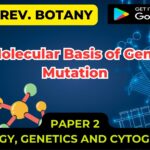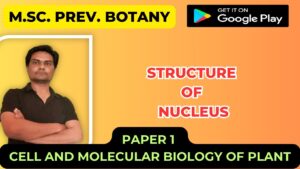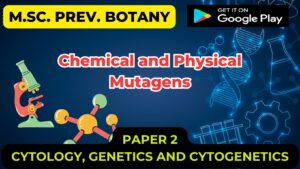DNA Damage Repair Mechanism & Defect On Repair Mechanism
Introduction to DNA Damage and Repair:
- DNA is a stable and versatile molecule.
- But sometimes the damage is caused to it,
- it is able to maintain the stability by the information contained in it.
- DNA has many elaborate mechanisms to repair any damage or distortion.
- The most frequent sources of damage to DNA are the inaccuracy in DNA replication and chemical changes in DNA.
- Malfunction of the process of replication can lead to incorporation of wrong bases, which are mismatched with the complementary strand.
- The damage causing chemicals break the backbone of the strand and chemically alter the bases.
- Alkylation, oxidation and methylation cause damage to bases. X-rays and gamma radiations cause single or double stranded breaks in DNA.
- A change in the sequence of bases if replicated and passed on to the next generation becomes permanent and leads to mutation.
- At the same time mutations are also necessary which provide raw material for evolution.
- Without evolution, the new species, even human beings would not have arisen.
- Therefore a balance between mutation and repair is necessary.
Types of Damage:
Damage to DNA includes any deviation from the usual double helix structure.
1. Simple Mutations:
- Simplest mutations are switching of one base for another base.
- In transition one pyrimidine is substituted by another pyramidine and purine with another purine.
- Trans-version involves substitution of a pyramidine by a purine and purine by a pyrimidine such as T by G or A and A by C or T.
- Other simple mutations are detection, insertion of a single nucleotide or a small number of nucleotides.
- Mutations which change a single nucleotide are called point mutations.
2. Deamination:
- The common alteration of form or damage includes deamination of cytosine (C) to form uracil (u) which base pairs with adenine (A) in next replication instead of guanine (G) with which the original cytosine would have paired.
- As uracil is not present in DNA, adenine base pairs with thymine (T).
- Therefore C-G pair is replaced by T-A in next replication cycle. Similarly, hypoxanthine results from adenine deamination.
3. Missing Bases:
- Cleavage of N-glycosidic bond between purine and sugar causes loss of purine base from DNA.
- This is called depurination.
- This apurinic site becomes non-coding lesion.
4. Chemical Modification of Bases:
- Chemical modification of any of the four bases of DNA leads to modified bases.
- Methyl groups are added to various bases. Guanine forms 7- methylguanine, 3-methylguanine. Adenine forms 3-methyladenine.
- Cytosine forms 5- Methylcytosine.
- Replacement of amino group by a keto group converts 5-methylcytosine to thymine.
5. Formation of Pyrimidine Dimers (Thymine Dimers):
- Formation of thymine dimers is very common in which a covalent bond (cyclobutyl ring) is formed between adjacent thymine bases.
- This leads to loss of base pairing with opposite stand.
- A bacteria may have thousands of dimers immediately after exposure to ultraviolet radiations.
6. Strand Breaks:
- Sometimes phosphodiester bonds break in one strand of DNA helix.
- This is caused by various chemicals like peroxides, radiations and by enzymes like DNases.
- This leads to breaks in DNA backbone.
- Single strand breaks are more common than double strand breaks.
- Sometimes X-rays, electronic beams and other radiations may cause phosphodiester bonds breaks in both strands which may not be directly opposite to each other.
- This leads to double strand breaks.
- Some sites on DNA are more susceptible to damage. These are called hot-stops.
Repair Mechanisms:
- Most kinds of damage create impediments to replication or transcription.
- Altered bases cause mispairing and can cause permanent alteration to DNA sequence after replication.
- In order to maintain the integrity of information contained in it, the DNA has various repair mechanisms.
Xeroderma Pigmentosum (XP) –
- XP is a rare inherited disease of humans which, among other things, predisposes the patient to pigmented lesions on areas of the skin exposed to the sun and an elevated incidence of skin cancer.
- It turns out that XP can be caused by mutations in any one of several genes – all of which have roles to play in NER. Some of them:
- XPA, which encodes a protein that binds the damaged site and helps assemble the other proteins needed for NER.
- XPB and XPD, which are part of TFIIH. Some mutations in XPB and XPD also produce signs of premature aging.
- XPF, which cuts the backbone on the 5′ side of the damage
- XPG, which cuts the backbone on the 3′ side
Transcription-Coupled NER –
- Nucleotide-excision repair proceeds most rapidly in cells whose genes are being actively transcribed on the DNA strand that is serving as the template for transcription.
- This enhancement of NER involves XPB, XPD, and several other gene products.
- The genes for two of them are designated CSA and CSB (mutations in them cause an inherited disorder called Cockayne’s syndrome).
- Synthesizing messenger RNA (mRNA), providing a molecular link between transcription and repair.
- One plausible scenario: If RNA polymerase II
- The CSB product associates in the nucleus with RNA polymerase II, the enzyme responsible for, tracking along the template (antisense) strand), encounters a damaged base, it can recruit other proteins, e.g., the CSA and CSB synthesizing messenger RNA (mRNA), providing a molecular link between transcription and repair.
- One plausible scenario: If RNA polymerase II proteins, to make a quick fix before it moves on to complete transcription of the gene.
Mismatch Repair (MMR) –
- Mismatch repair deals with correcting mismatches of the normal bases; that is, failures to maintain normal Watson-Crick base pairing (A•T, C•G).
- It can enlist the aid of enzymes involved in both base-excision repair (BER) and nucleotide-excision repair (NER) as well as using enzymes specialized for this function.
- Recognition of a mismatch requires several different proteins including one encoded by MSH2. Cutting the mismatch out also requires several proteins, including one encoded by MLH1.
- Mutations in either of these genes predisposes the person to an inherited form of colon cancer.
- So these genes qualify as Tumor Suppressor Genes. Synthesis of the repair patch is done by the same enzymes used in NER: DNA polymerase delta and epsilon.
- Cells also use the MMR system to enhance the fidelity of recombination; i.e., assure that only homologous regions of two DNA molecules pair up to crossover and recombine segments (e.g., in meiosis).
Repairing Strand Breaks –
- Ionizing radiation and certain chemicals can produce both single-strand breaks (SSBs) and double-strand breaks (DSBs) in the DNA backbone.
Single-Strand Breaks (SSBs) –
- Breaks in a single strand of the DNA molecule are repaired using the same enzyme systems that are used in Base-Excision Repair (BER).
Double-Strand Breaks (DSBs) –
- There are two mechanisms by which the cell attempts to repair a complete break in a DNA molecule: Direct joining of the broken ends.
- This requires proteins that recognize and bind to the exposed ends and bring them together for ligating.
- They would prefer to see some complementary nucleotides but can proceed without them so this type of joining is also called Non-Homologous End-Joining (NHEJ).
- Errors in direct joining may be a cause of the various translocations that are associated with cancers.
- Examples: Burkitt’s lymphoma – the Philadelphia chromosome in Chronic Myelogenous Leukemia (CML) B-cell leukemia Homologous Recombination.
- Here the broken ends are repaired using the information on the intact Sister Chromatid (available in G2 after chromosome duplication), or on the Homologous chromosome (in G1; that is, before each chromosome has been duplicated).
- This requires searching around in the nucleus for the homolog – a task sufficiently uncertain that G1 cells usually prefers to mend their DSBs by NHEJ or on the same chromosome if there are duplicate copies of the gene on the chromosome oriented in opposite directions (head-to-head or back-to-back).
- Two of the proteins used in homologous recombination are encoded by the genes BRCA1 and BRCA2.
- Inherited mutations in these genes predispose women to breast and ovarian cancers.
Meiosis also involves DSBs –
- Recombination between homologous chromosomes in meiosis I also involves the formation of DSBs and their repair. So it is not surprising that this process uses the same enzymes.
- Meiosis I with the alignment of homologous sequences provides a mechanism for repairing damaged DNA; that is, mutations. in fact, many biologists feel that the main function of sex is to provide this mechanism for maintaining the integrity of the genome.
- However, most of the genes on the human Y chromosome have no counterpart on the X chromosome, and thus cannot benefit from this repair mechanism.
- They seem to solve this problem by having multiple copies of the same gene – oriented in opposite directions.
- Looping the intervening DNA brings the duplicates together and allowing repair by homologous recombination.
Gene Conversion –
- If the sequence used as a template for repairing a gene by homologous recombination differs slightly from the gene needing repair; that is, is an allele, the repaired gene will acquire the donor sequence.
- This nonreciprocal transfer of genetic information is called gene conversion.
- The donor of the new gene sequence may by: the homologous chromosome (during meiosis) the sister chromatid (also during meiosis) a duplicate of the gene on the same chromosome (during mitosis)
- Gene conversion during meiosis alters the normal mendelian ratios. Normally, meiosis in a heterozygous (A,a) parent will produce gametes or spores in a 1:1 ratio; e.g., 50% A; 50% a.
- However, if gene conversion has occurred, other ratios will appear. If, for example, an A allele donates its sequence as it repairs a damaged a allele, the repaired gene will become A, and the ratio will be 75% A; 25% a.






